Discover the importance of proper lingerie fit and navigate international size variations with expert guides and conversion charts for a seamless and confident shopping experience.
Why Proper Lingerie Fit Matters
Proper lingerie fit is essential for comfort‚ confidence‚ and overall well-being. Ill-fitting lingerie can cause discomfort‚ skin irritation‚ or even health issues like poor posture or breathing difficulties. A well-fitted bra provides adequate support‚ reducing strain on shoulders and back. It also enhances confidence‚ allowing you to feel your best in any outfit. Additionally‚ proper fit ensures longevity of the garment‚ as it prevents stretching or damage from improper wear. Investing in the right size boosts self-esteem and ensures a seamless‚ flattering appearance.
Overview of Lingerie Size Systems
Lingerie size systems vary globally‚ with the US and UK using a combination of band and cup sizes‚ while Europe employs a numbered system. These systems aim to provide a comfortable‚ supportive fit. Accurate measurements are key to finding the right size. Sister sizes help maintain cup volume when adjusting band sizes. However‚ sizes can vary between brands‚ so checking individual charts is essential for the best fit.
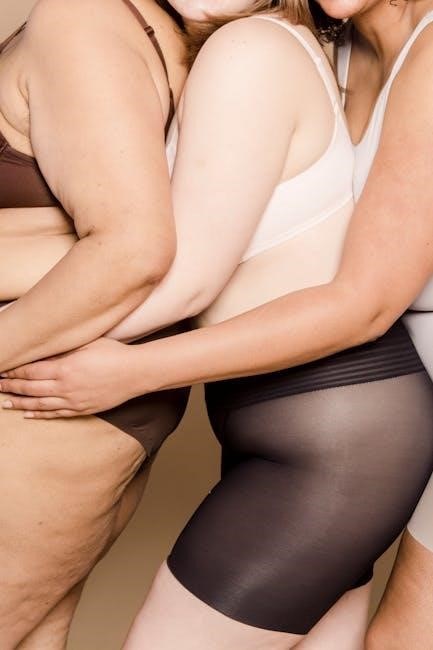
Understanding Your Measurements
Accurate measurements ensure a proper fit. Consistency is key; measure at the same time daily. Band size‚ cup size‚ and body changes all impact your fit.
How to Measure Your Band Size
To measure your band size‚ wrap a flexible tape measure snugly around your torso‚ directly under your bust. Ensure the tape is level and parallel to the floor. The measurement in inches will give your band size. For accuracy‚ exhale slightly and avoid slouching. If the number is odd‚ round up to the nearest even number. Proper band fit ensures comfort and support. Note: Band sizes vary slightly between brands‚ so refer to specific size charts for consistency.
How to Measure Your Cup Size
To measure your cup size‚ wear a non-padded‚ well-fitting bra and wrap a flexible tape measure around the fullest part of your bust. Keep the tape level and parallel to the floor. Subtract your band size from this measurement to determine your cup size. For example‚ if your bust measures 36 inches and your band size is 34 inches‚ the difference is 2 inches‚ corresponding to a B cup. Ensure the tape isn’t too tight or too loose for accurate results. Proper cup fit ensures no gapping or spillage‚ providing comfort and support. Always refer to size charts for consistency.
How to Determine Your Sister Sizes
Sister sizes are sizes that share the same cup volume but have different band and cup combinations. To find your sister sizes‚ move up one band size and down one cup size‚ or vice versa. For example‚ if you wear a 34B‚ your sister sizes are 32C and 36A. This allows you to stay within your cup volume while adjusting the band for a more comfortable fit. Sister sizes are helpful when your current size feels too tight or loose‚ ensuring better support and comfort without compromising on style or coverage.
International Size Conversions
Discover how lingerie sizes vary globally‚ with specific charts for US‚ UK‚ European‚ and Australian standards. Understand conversions to find your perfect fit worldwide seamlessly.
US to UK Bra Size Conversion
Understanding the differences between US and UK bra sizes is crucial for accurate fitting. US sizes use a combination of numbers and letters (e.g.‚ 34A)‚ while UK sizes use numbers only (e.g.‚ 34A). Generally‚ US cup sizes align with UK cup sizes (A-A‚ B-B‚ etc.)‚ but there are slight variations in larger cup sizes. For example‚ a US DD is equivalent to a UK E. Always refer to a conversion chart to ensure precision. Professional fittings can also help bridge any discrepancies for a perfect match.
European Bra Size Conversion
European bra sizes differ from US and UK systems‚ often using a numbering system without letters. For band sizes‚ European sizes are typically calculated by adding 30 or 31 to the ribcage measurement in inches. Cup sizes‚ however‚ align closely with UK sizes‚ with A being the smallest. For example‚ a European 65B corresponds roughly to a UK 32B. Always consult a detailed conversion chart for accuracy‚ as variations exist between brands. Professional fittings can also provide personalized guidance for the best fit.
Australian Bra Size Conversion
Australian bra sizes are similar to UK and New Zealand systems but have distinct features. Band sizes are determined by adding 10 to the ribcage measurement in centimeters‚ while cup sizes follow letters A to G‚ representing increasing volumes. For example‚ a 12B in Australia corresponds to a 34B in the US. Some Australian brands also offer larger cup sizes up to K. While there’s a general guide‚ sizes can vary slightly between brands‚ so checking specific charts or seeking professional fittings is recommended for accuracy and comfort.

Specialized Lingerie Sizing
Specialized lingerie sizing caters to unique needs‚ like French couture or latex fits‚ ensuring precision and comfort for diverse body types and preferences.
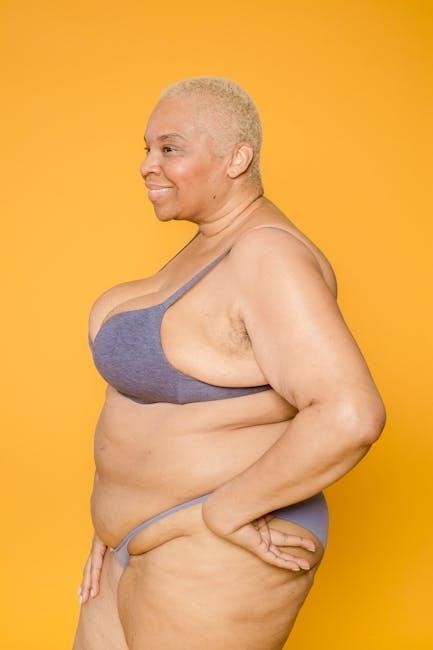
French Lingerie Size Charts
French lingerie size charts emphasize elegance and precision‚ often featuring detailed measurements tailored to European fits. They typically include band sizes (like 85-100) and cup sizes (A-G)‚ ensuring a snug yet comfortable fit. French brands may use slightly different cup volume calculations compared to other countries‚ prioritizing a natural silhouette. Many French lingerie labels also offer half sizes‚ providing extra customization. These charts cater to a wide range of body types‚ ensuring every woman can find her perfect match for both style and comfort.
Latex Lingerie Size Guide
Latex lingerie size guides require careful consideration due to the material’s stretchy nature. Unlike traditional fabrics‚ latex molds to the body‚ so a snug fit is essential to avoid excessive stretching over time. Sizes often align closely with standard bra measurements but may vary slightly due to latex’s unique properties. Many brands provide detailed charts to ensure accuracy‚ as improper sizing can compromise comfort and appearance. When selecting latex lingerie‚ prioritize precise measurements and consider the stretchiness to achieve the desired fit and aesthetic.
Measuring for Custom or Bespoke Lingerie
Measuring for custom lingerie requires precise body measurements‚ including band‚ cup‚ and torso lengths. Use a flexible tape measure and consult the designer’s specific guidelines for accuracy and comfort.
How to Measure for Haute Couture Lingerie
Measuring for haute couture lingerie involves precise measurements of your band‚ cup‚ hip‚ and waist. Use a flexible tape measure‚ ensuring it’s level and snug but not tight. Note any asymmetries or postural quirks. Record measurements in both inches and centimeters for accuracy. Some designers may request additional measurements‚ such as torso length or bust point placement. Fabric stretch and personal comfort preferences should also be considered. For intricate designs‚ a professional fitter may be recommended to ensure a flawless fit.
Considerations for Plus-Size Lingerie
When choosing plus-size lingerie‚ prioritize support and comfort while ensuring a flattering fit. Look for wide‚ adjustable straps and reinforced bands to provide stability. Opt for breathable fabrics that minimize discomfort and irritation. Consider styles with larger cups‚ seamed bras‚ or structured shapewear for better containment. Pay attention to sizing charts specific to plus-size ranges‚ as they may differ from standard sizing. Enhance confidence by selecting designs that celebrate curves‚ offering both functionality and aesthetic appeal. Proper fit ensures longevity and optimal comfort for everyday wear.
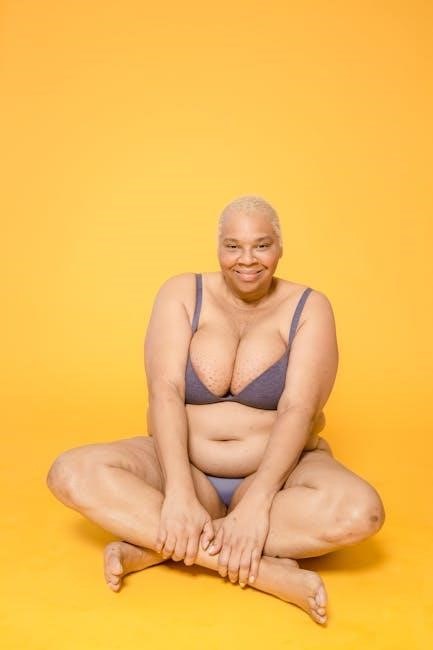
Factors Affecting Lingerie Fit
Body changes‚ fabric stretchiness‚ and personal preferences significantly impact lingerie fit. Accurate measurements ensure optimal comfort and support regardless of style or material chosen.
Body Changes and Size Adjustments
Body changes‚ such as weight fluctuations‚ hormonal shifts‚ or pregnancy‚ can alter lingerie fit. Regular measurements ensure optimal comfort and support. Weight gain or loss affects band and cup sizes‚ while pregnancy and breastfeeding often require larger cup sizes and adjustable bands. Aging can cause changes in breast density and shape‚ impacting cup fit. Seasonal fluctuations‚ like water retention‚ may also influence size. Staying aware of these changes and updating sizes accordingly ensures a perfect fit and enhances confidence and comfort in your lingerie choices.
Fabric Types and Stretchiness
Fabric types and stretchiness significantly impact lingerie fit. Lace‚ cotton‚ and silk are common materials‚ each offering varying levels of breathability and flexibility. Stretch fabrics‚ like spandex blends‚ provide elasticity‚ allowing garments to adapt to body movement. Understanding fabric stretchiness helps determine whether a size will accommodate your body comfortably. For instance‚ non-stretch fabrics may require precise sizing‚ while stretchy fabrics offer more forgiveness. Choosing the right fabric ensures comfort and support‚ making it essential to consider when selecting lingerie sizes.

Visual Guide to Lingerie Sizing
A visual guide to lingerie sizing includes charts and diagrams that clearly illustrate band and cup sizes‚ helping you understand how different sizes correspond to body measurements;
Charts for Band and Cup Sizes
Charts for band and cup sizes are essential tools in determining your lingerie fit. These visual aids display measurements in a table format‚ correlating band sizes with cup sizes. They typically include numerical or alphabetical band measurements alongside cup sizes (e.g.‚ AA‚ A‚ B). Charts may vary slightly by region or brand but generally follow standard sizing conventions. Using a tape measure‚ you can match your measurements to the chart to find your ideal size. This helps ensure a comfortable and flattering fit for any lingerie style.
Illustrations of Proper Fit
Illustrations of proper fit are visual guides that show how lingerie should look and feel on different body types. These diagrams often highlight key features‚ such as seamless alignment‚ comfortable straps‚ and smooth fabric distribution. They help identify signs of a correct fit‚ like a band that sits level and cups that fully contain the bust without spillage. Many charts also include images for various styles‚ ensuring the fit suits the specific design. These visuals are invaluable for understanding how lingerie should fit‚ aiding in selecting the right size and style for comfort and confidence.
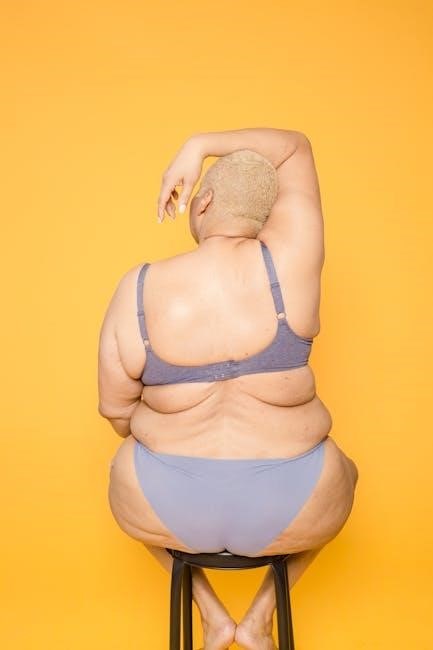
Style-Specific Sizing Tips
Different lingerie styles require tailored sizing approaches. For example‚ bras may need cup adjustments‚ while panties fit based on hip measurements. Always consider fabric stretch and design elements for optimal comfort and support.
Bralettes vs. Underwire Bras
Bralettes and underwire bras differ significantly in sizing and fit. Bralettes‚ being wireless‚ prioritize comfort and flexibility‚ often offering a more relaxed fit. They may not require precise cup sizing but should still fit snugly around the band. Underwire bras‚ however‚ rely on accurate measurements for both band and cup sizes to ensure proper support and avoid discomfort. Choose styles that align with your body type and lifestyle‚ ensuring the underwire sits flat against your chest for optimal fit and comfort.
Shapewear and Waist Training Garments
Shapewear and waist training garments serve distinct purposes. Shapewear is designed to smooth and compress‚ offering a seamless look under clothing‚ while waist trainers are tailored for waist reduction and posture improvement. When sizing‚ consider both compression level and comfort. Shapewear sizes often align with standard clothing sizes‚ while waist trainers may require precise torso measurements. Ensure the garment sits correctly without restricting movement or causing discomfort. Proper fit is crucial for both aesthetic appeal and health benefits‚ balancing compression with breathability and mobility. Always prioritize comfort to avoid potential discomfort or health issues.
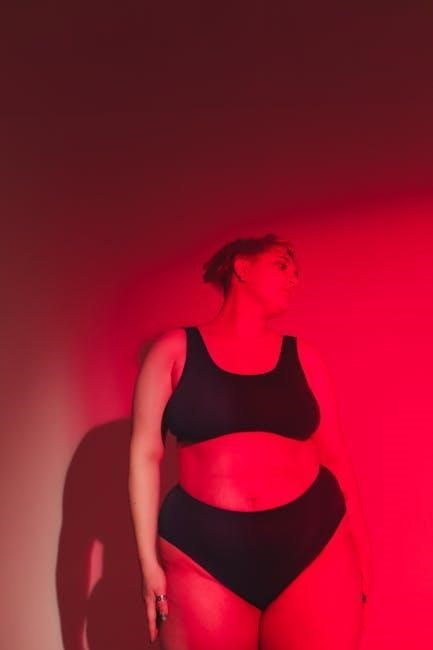
Common Mistakes in Lingerie Sizing
Common mistakes include relying on outdated measurements‚ ignoring sister sizes‚ and assuming all brands fit the same. Proper fitting requires accurate‚ current measurements and understanding size variations across brands to ensure comfort and support. Always measure regularly and consult size charts to avoid ill-fitting lingerie that can cause discomfort or health issues. Prioritize precise measurements and brand-specific guidelines for the best results and satisfaction. Regular updates and professional fittings can help maintain the perfect fit over time‚ accommodating body changes and personal preferences.
Assuming One Size Fits All
One of the most common mistakes is assuming one size fits all‚ which can lead to poor fit and discomfort. Body types and proportions vary significantly‚ and sizes differ between brands and styles. Ignoring these differences can result in bras that dig‚ gape‚ or lack support. Many women also overlook the need for professional fittings‚ which can reveal size variations they weren’t aware of. Additionally‚ not considering cup size ratios or band tightness can exacerbate the issue. Always consult size charts and try styles on to ensure a flattering‚ comfortable fit tailored to your unique silhouette.
Not Considering Body Type Variations
Ignoring body type variations is a common mistake that can hinder finding the perfect lingerie fit. Bodies come in diverse shapes‚ such as hourglass‚ pear‚ apple‚ and rectangular‚ each requiring tailored approaches. For instance‚ petites may need shorter band lengths‚ while taller individuals might prefer longer bands. Additionally‚ breast shapes and distributions vary‚ affecting cup size accuracy. Failing to account for these differences can lead to discomfort‚ poor support‚ or unflattering silhouettes. Always choose styles designed for your specific body type to ensure optimal comfort and aesthetics.
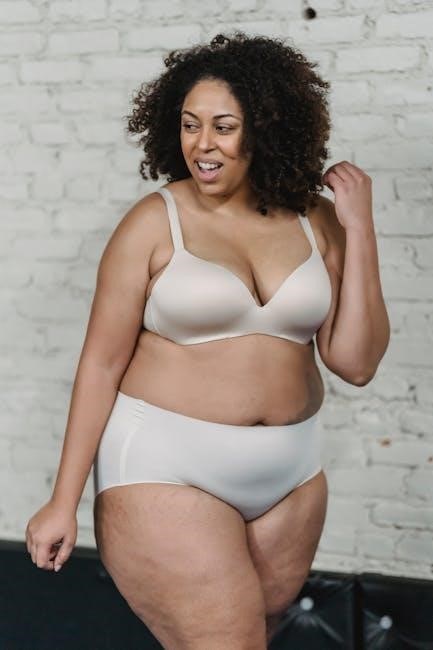
Brand-Specific Size Guides
Brand-specific size guides vary due to unique design approaches and target audiences. Always consult individual brand charts for accurate fitting‚ as sizing can differ significantly between labels.
Elomi Lingerie Size Guide
Elomi lingerie offers an extensive size range‚ catering to plus-size and full-busted women. Their size guide includes detailed band and cup measurements‚ ensuring a comfortable fit. Elomi sizes typically range from 34-48 bands and cups up to K. They emphasize the importance of professional measurements and offer sister size options for customization. The brand focuses on supportive‚ stylish designs‚ making their size chart a reliable tool for finding the perfect fit. Always refer to Elomi’s official size chart for accurate results.
Goddess Lingerie Size Chart
Goddess lingerie caters to plus-size women‚ offering a size range from 38-56 in bands and cup sizes up to O. Their size chart is designed for comfort and support‚ focusing on a smooth transition between sizes. Goddess emphasizes the importance of proper fit and provides detailed measurements to ensure accuracy. The brand uses high-quality materials for durability and comfort. To find your perfect size‚ refer to their official chart and consider professional fittings for the best results. Goddess lingerie is known for its inclusive sizing and elegant designs.
Finding the perfect fit is transformative. This guide has provided comprehensive insights to help you navigate lingerie sizing with confidence and embrace your true self.
Final Tips for the Perfect Fit
Invest in regular fittings to accommodate body changes. Prioritize comfort and support over trends. Experiment with styles to find what flatters your silhouette. Don’t hesitate to seek professional advice for personalized solutions. Remember‚ the right fit boosts confidence and comfort. Embrace your unique shape and explore brands that cater to your needs. Confidence shines brightest when you feel your best.
Encouragement to Explore and Experiment
Embrace the journey of discovering your perfect fit by exploring different styles and sizes. Lingerie is a personal choice‚ and there’s no one-size-fits-all solution. Don’t be afraid to try new brands or designs—what works for someone else might not work for you. Stay open to trends and innovations‚ as they can introduce you to your new favorites. Remember‚ confidence and comfort are the ultimate goals. Take your time‚ and don’t hesitate to seek help from professionals or online resources to find what makes you feel your best.
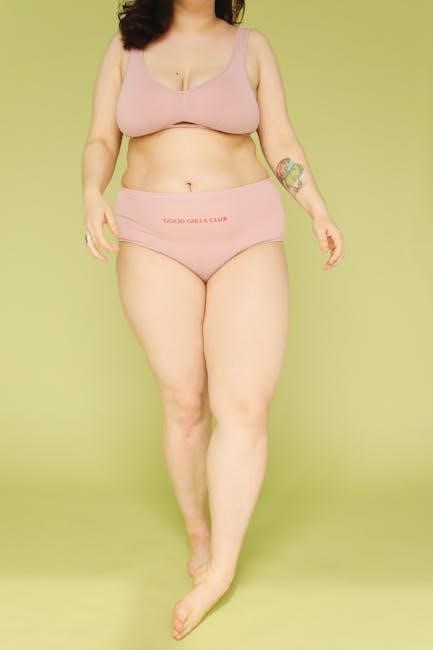
Additional Resources
Explore recommended websites for size conversion tools and professional fitting guides. Utilize online communities and forums for personalized advice and real-user experiences with lingerie sizing.
Recommended Websites for Size Conversion
For accurate lingerie size conversion‚ visit trusted websites like Calvin Klein and Victoria’s Secret for their detailed size charts. Specialty stores such as Bravissimo cater to plus sizes‚ while HerRoom offers comprehensive guides. International brands like Eres (French sizes) and Triangl (Australian fits) provide region-specific measurements. Use SizeGuide.com for universal conversion tools. These resources ensure a precise fit‚ catering to diverse needs and preferences.
Professional Fittings and Consultants
Consulting a professional fitter or lingerie consultant can ensure a flawless fit. Many luxury retailers‚ like Nordstrom and Selfridges‚ offer complimentary fitting services. Experts analyze your measurements and recommend styles tailored to your body. Boutiques specializing in lingerie‚ such as La Perla‚ provide personalized consultations; Some consultants even offer virtual fittings for convenience. A professional fitting is invaluable for discovering your true size and exploring brands that flatter your figure‚ ensuring comfort and confidence in your lingerie choices.
Frequently Asked Questions
Discover answers to common queries about lingerie sizing‚ such as how often to replace bras‚ how to maintain fit‚ and tips for accurate size determination.
How Often Should I Update My Lingerie Sizes?
It’s essential to update your lingerie sizes regularly‚ as your body can change due to weight fluctuations‚ hormonal shifts‚ or aging; Experts recommend getting refitted every 6-12 months to ensure a proper fit. Bras‚ in particular‚ should be replaced every 1-2 years‚ as elastic loses its stretch over time. Additionally‚ pregnancy‚ menopause‚ or significant weight changes may require more frequent updates. Always prioritize comfort and support‚ as ill-fitting lingerie can lead to discomfort and long-term health issues. Regular check-ins with a professional fitter are highly encouraged for optimal results.
Can I Use International Charts for Accurate Fitting?
International lingerie size charts can be helpful‚ but they may not always ensure precise fitting due to differences in sizing standards across regions. US‚ UK‚ and EU sizes often vary slightly‚ and body types differ globally‚ affecting how garments fit. While these charts provide a good starting point‚ they should be used alongside personal measurements and professional fittings for accuracy. Combining multiple resources and understanding your unique body shape will help achieve the best fit. Always check brand-specific guidelines‚ as sizing can differ between labels and regions.